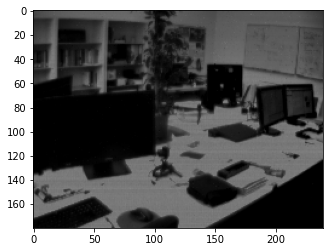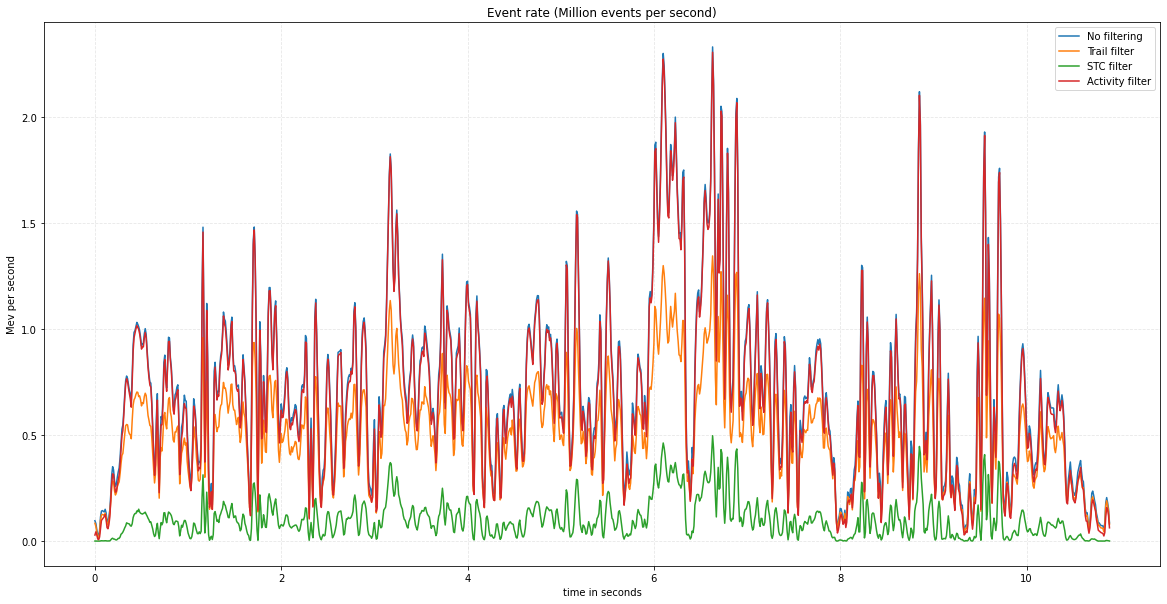Interfacing with Davis 240C Dataset
This tutorial shows how to read data from an external source (Davis 240C Dataset) and to convert it into Metavision EventCD format. Then we show how to apply various events filtering algorithms and display some basic statistics about the event-rate.
from tqdm.notebook import tqdm
import requests
import os
import matplotlib.pyplot as plt
%matplotlib inline
sequence_name = "office_zigzag"
sequence_filename = "{}.zip".format(sequence_name)
if not os.path.exists("{}".format(sequence_filename)):
url = "http://rpg.ifi.uzh.ch/datasets/davis/{}".format(sequence_filename)
# Streaming, so we can iterate over the response.
r = requests.get(url, stream=True)
# Total size in bytes.
total_size = int(r.headers.get('content-length', 0))
block_size = 1024
t = tqdm(total=total_size, unit='iB', unit_scale=True)
with open('{}'.format(sequence_filename), 'wb') as f:
for data in r.iter_content(block_size):
t.update(len(data))
f.write(data)
t.close()
if total_size != 0 and t.n != total_size:
print("ERROR, something went wrong")
else:
print("File already exists")
assert os.path.exists("{}".format(sequence_filename))
File already exists
Display the images
Then we display the images for that particular sequence.
from zipfile import ZipFile
import cv2
import numpy as np
from ipywidgets import interact
from PIL import Image
list_images = []
with ZipFile(sequence_filename, 'r') as myzip:
with myzip.open("images.txt") as images_file:
for line in images_file.readlines():
line = line.strip()
if line == "":
continue
filename_image = line.split()[1].decode()
nparr = np.frombuffer(myzip.open(filename_image).read(), np.uint8)
img_np = cv2.imdecode(nparr, cv2.IMREAD_COLOR) # cv2.IMREAD_COLOR in OpenCV 3.1
list_images.append(img_np)
def display_sequence(images):
def _show(frame=(0, len(images)-1)):
return Image.fromarray(images[frame])
interact(_show)
plt.imshow(list_images[len(list_images) // 2])
display_sequence(list_images)

interactive(children=(IntSlider(value=123, description='frame', max=247), Output()), _dom_classes=('widget-int…
Load the events
Then, we load the sequence of events from the text file (one event per line). Once the file is read,
the python dictionary is converted into a numpy structured array of EventCD. This numpy array can be saved using
standard function numpy.save() and reloaded using standard function numpy.load().
from metavision_sdk_base import EventCD # numpy dtype
sequence_npy = "{}.npy".format(sequence_name)
if not os.path.exists(sequence_npy):
print("Processing filename: ", sequence_filename)
dic_events = {}
for name in EventCD.names:
dic_events[name] = []
with ZipFile(sequence_filename, 'r') as myzip:
with myzip.open("events.txt") as events_file:
for line in tqdm(events_file):
line = line.decode().strip()
if line == "":
continue
t, x, y, p = line.split()
ev = np.empty(1, dtype=EventCD)
dic_events["x"].append(int(x))
dic_events["y"].append(int(y))
dic_events["p"].append(int(p))
dic_events["t"].append(int(float(t) * 1e6))
events_np = np.empty(len(dic_events["x"]), dtype=EventCD)
for name in EventCD.names:
events_np[name] = np.array(dic_events[name])
np.save(sequence_npy, events_np)
else:
events_np = np.load(sequence_npy)
assert events_np.dtype == EventCD
print("Loaded {} events".format(len(events_np)))
Loaded 7735308 events
This numpy structured array of EventCD is the input format for various Metavision algorithms. In the next section, we will apply several event filtering algorithms and compare their results.
Comparing: Activity / SpatioTemporalContrast / Trail
In this section, we show how to apply several filtering algorithms on
the sequence of events. We process events by chunks of 10 ms
(delta_t = 10000). We then convert the filtered events into visual
frames display them side-by-side for visual inspection.
import metavision_sdk_cv
from metavision_sdk_core import BaseFrameGenerationAlgorithm
import cv2
height, width, _ = list_images[0].shape
assert (events_np["x"] < width).all()
assert (events_np["y"] < height).all()
trail_filter = metavision_sdk_cv.TrailFilterAlgorithm(width=width, height=height, threshold=10000)
stc_filter = metavision_sdk_cv.SpatioTemporalContrastAlgorithm(width=width, height=height, threshold=10000)
activity_filter = metavision_sdk_cv.ActivityNoiseFilterAlgorithm(width=width, height=height, threshold=20000)
trail_buf = trail_filter.get_empty_output_buffer()
stc_buf = stc_filter.get_empty_output_buffer()
activity_buf = activity_filter.get_empty_output_buffer()
list_images_concat = []
list_nb_ev = []
list_nb_ev_trail = []
list_nb_ev_stc = []
list_nb_ev_activity = []
ts = 0
start_idx = 0
delta_t = 10000
im = np.zeros((height, width, 3), dtype=np.uint8)
im_trail = im.copy()
im_stc = im.copy()
im_activity = im.copy()
while start_idx < len(events_np):
ts += delta_t
end_idx = np.searchsorted(events_np["t"], ts)
ev = events_np[start_idx:end_idx]
start_idx = end_idx
trail_filter.process_events(ev, trail_buf)
stc_filter.process_events(ev, stc_buf)
activity_filter.process_events(ev, activity_buf)
ev_trail = trail_buf.numpy()
ev_stc = stc_buf.numpy()
ev_activity = activity_buf.numpy()
list_nb_ev.append(ev.size)
list_nb_ev_trail.append(ev_trail.size)
list_nb_ev_stc.append(ev_stc.size)
list_nb_ev_activity.append(ev_activity.size)
BaseFrameGenerationAlgorithm.generate_frame(ev, im)
BaseFrameGenerationAlgorithm.generate_frame(ev_trail, im_trail)
BaseFrameGenerationAlgorithm.generate_frame(ev_stc, im_stc)
BaseFrameGenerationAlgorithm.generate_frame(ev_activity, im_activity)
im_concat = np.concatenate((im, im_trail, im_stc, im_activity), axis=1)
im_concat[:, width, 0] = 255
im_concat[:, 2*width, 1] = 255
im_concat[:, 3*width, 0:2] = 255
list_images_concat.append(im_concat)
cv2.imshow("{} [ original | trail | stc | activity ]".format(sequence_name), im_concat[:, :, ::-1])
if cv2.waitKey(1) & 0xFF == ord('q'):
break
cv2.destroyAllWindows()
fig = plt.figure(figsize=(20, 10))
plt.imshow(list_images_concat[len(list_images_concat) // 2])
display_sequence(list_images_concat)

interactive(children=(IntSlider(value=544, description='frame', max=1089), Output()), _dom_classes=('widget-in…
Finally, we draw a plot to display the evolution of the event-rate over the course of the sequence for the different filtering strategies.
time_in_seconds = np.arange(0, len(list_nb_ev) * delta_t * 1e-6, delta_t * 1e-6)
fig = plt.figure(figsize=(20, 10))
ax = plt.axes()
plt.grid(alpha=0.3, linestyle="--")
plt.plot(time_in_seconds, np.array(list_nb_ev) / delta_t, label="No filtering")
plt.plot(time_in_seconds, np.array(list_nb_ev_trail) / delta_t, label='Trail filter')
plt.plot(time_in_seconds, np.array(list_nb_ev_stc) / delta_t, label='STC filter')
plt.plot(time_in_seconds, np.array(list_nb_ev_activity) / delta_t, label='Activity filter')
plt.xlabel('time in seconds')
plt.ylabel('Mev per second')
plt.title("Event rate (Million events per second)")
plt.legend()
plt.show()

Conclusion
We have shown how to convert an external dataset of events into Metavision EventCD format and how to seamlessly apply algorithms to filter those events. As this format relies on standard numpy structured arrays, saving/reloading/slicing and interfacing with various python-based components is straightforward.